Features of planting radishes in July
Radish is a useful and nutritious root vegetable, it contains not only vitamins, but also, for example, such an important element as iodine. Therefore, summer residents strive to grow this vegetable both in spring and summer, and sometimes even in early autumn.
In the article we will tell you how to plant radishes in July so that it does not go into the arrow and give a rich harvest.
The content of the article
Is it possible to plant radishes in July
Novice gardeners are worried about whether it is possible to plant radishes in mid-July.
Optimal daylight hours for large and juicy root crops it takes 9-10 hours.
In June, when the daylight hours increase to 14 hours or more, radish from development goes to reproduction. The plant shoots, does not yield (or the roots will be small and tasteless). Therefore, radishes are not planted in June and early July.
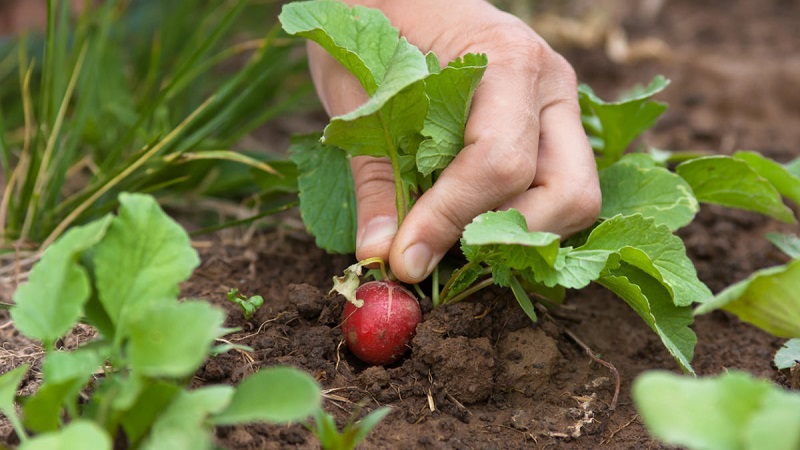
But when sowing the seeds of this vegetable in the middle and at the end of July, excellent fruits are obtained... In the middle of summer, summer residents have just a few beds vacated. By the end of July, it becomes not so hot, daylight hours are shorter - these are ideal conditions for growing radishes.
Best varieties to grow in July
In July you can plant radishes of those varieties that are resistant to shooting even with long daylight hours and high air temperatures. They are successfully grown in summer, and the fruits are large, juicy and crunchy.
These varieties are distinguished:
- Sora - resistant to high temperatures, ideal for summer planting;
- Ilke - can be planted in July and August (ripens in 4-5 weeks), does not start up arrows and is well stored;
- Rebel - the taste is pronounced, harsh, it can be planted all summer until the end of August;
- Carmen - the variety is not prone to flowering, bright red fruits remain juicy for a long time;
- Dubel - this type of radish also does not go into the arrows;
- Faith - oval-shaped fruits do not crack or shoot;
- Pharaoh - it can be sown several times per season, gives an excellent harvest;
- French breakfast - suitable for growing from late April to early September;
- Diego - resistant to diseases and flowers, fruits weighing 20-40 g;
- Tarzan is an all-season radish, resistant to high and low temperatures;
- Cherriet F1 - hybrid for July planting, round-shaped fruits, excellent presentation, good keeping quality.
Features of growing during this period
The growth of the plant and the formation of root crops depend on the cultivation technology... After all, if the plants form flowering stems, all the work will be in vain.
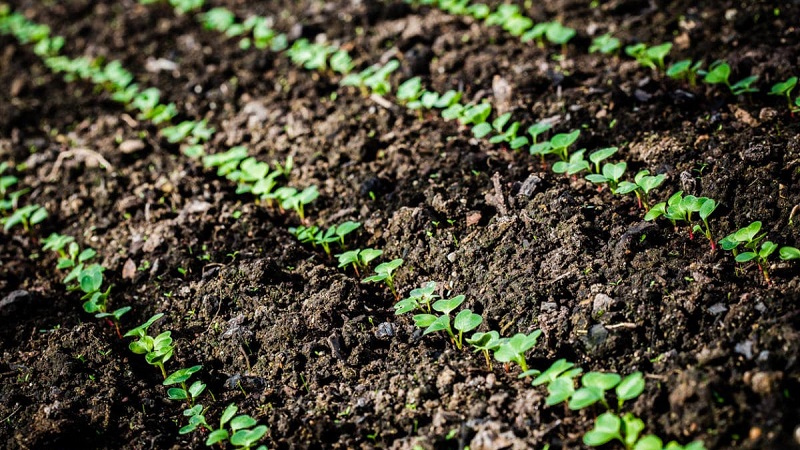
Site and soil preparation
Radish is not recommended to be sown after horseradish, cabbage, beets, rutabagas and daikon. But the plots for potatoes, tomatoes, peas, cucumbers and old strawberries are well suited for the radish harvest.
For July planting it is better to choose a place with partial shadingbecause the daylight hours are still too long for this culture. An area that is illuminated by the sun from morning until lunchtime or in the afternoon is suitable.
Re-boarding radish in July, usually occurs after the first vegetables are harvestedso the land is already prepared.
Before sowing, the land remains only to fertilize humus or compost (1 bucket per 1 m²) and wood ash (1 glass per 1 m²). The bed is leveled and watered, the next day they begin to sow.
Selection and preparation of seeds
To achieve a rich harvest, it is important to select quality seeds... With a suitable variety, each summer resident determines himself, focusing on the local climatic conditions and his own taste.
First, the seeds are sorted out. The best seed is 3 mm or more. The damaged and defective copies are discarded.
Before planting, the seeds are recommended to be kept in water or a damp cloth for 12-24 hours.
Landing technique and scheme
Summer residents use multiple seeding patterns... One of them involves the use of a match (also called "five by five"). This means that a distance of 5 cm is measured between the seeds, approximately equal to the length of the match.
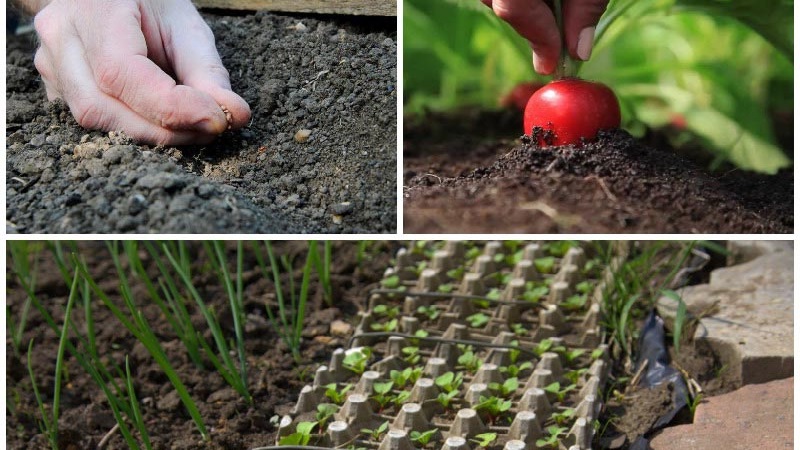
If this method is inconvenient, then you can use the egg grates: take a lattice and press its cells into the ground. This creates holes at an optimal distance.
There is one more simple option. When it is planned to grow a little radish, gardeners place the seeds by hand in the grooves made with a hoe. On a large plot, it is more convenient to use a manual mechanical seeder.
The seeds of this vegetable crop are planted to a depth of 1-3 cm (recommendations for a specific variety are indicated in the instructions on the package).
After embedding it is recommended to lightly press the soil over the seeds with your palm and water... This will help to get friendly uniform shoots.
Care rules
Sowing radishes in open ground in July is not difficult, but it is important to follow some rules of caring for it.
Thinning of seedlings
No later than a week after germination, young plants are thinned out, leaving a distance of 5 cm between them. This will allow you to get larger root crops.
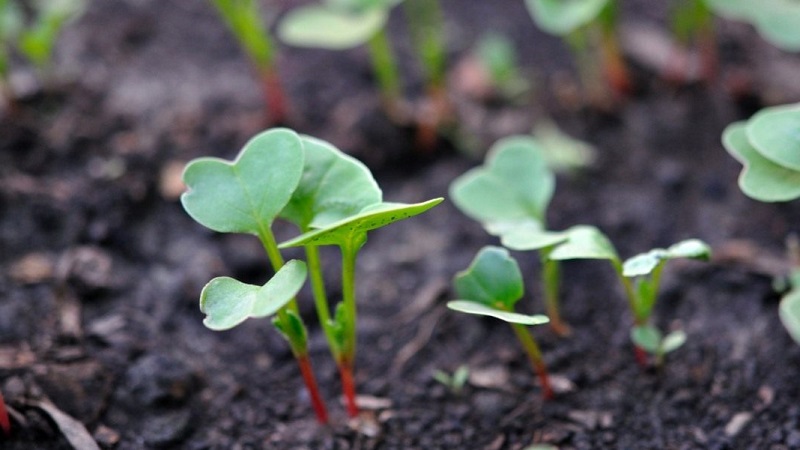
Watering
For the first time, the beds are watered abundantly after sowing... Even if the seeds were previously soaked in water, it is necessary to water the crops. It is optimal to use water at room temperature.
Watering with a watering can in the amount of 3-5 liters per 1 m², so that the earth is saturated with moisture to a depth of 20-30 cm. The soil must be constantly moist, otherwise the root crop will turn out to be "wooden" and tasteless.
On hot days, young shoots are watered in the morning and evening... After the roots begin to pour in, the frequency of watering is reduced to 2 times a week in cool weather and 3-4 times in hot weather.
The bushes are watered for the last time 5-7 hours before harvest: This will keep the vegetables better.
Fertilizer
To determine, what to fertilize radish shoots, pay attention to their appearance.
The leaves are large and bright, but there are no fruits yet... This indicates an excess of nitrogen compounds entering the vegetable in the garden. The reduction to the norm is facilitated by feeding with phosphorus and potassium fertilizers, diluted according to the instructions.
Pale foliage and small roots... The reason is nitrogen deficiency, which can be eliminated by feeding with nitrogen-containing fertilizers.
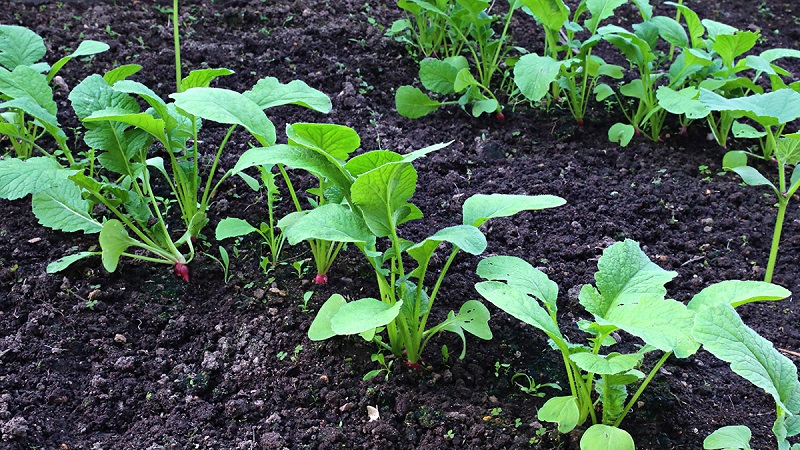
Loosening
Radish is a fast growing plant therefore, weeding is carried out only 2-3 times during the entire growing period.
After emergence, the soil is carefully loosened to a shallow depth (about 3 cm), then deeper (up to 7 cm) in order to increase the flow of air to the roots.
It is recommended to loosen the beds after each watering or rain... Loosening also helps to get rid of small weeds.
Disease and pest control
Insects can cause wilting of cruciferous crops (which include radishes) and reduce yields.
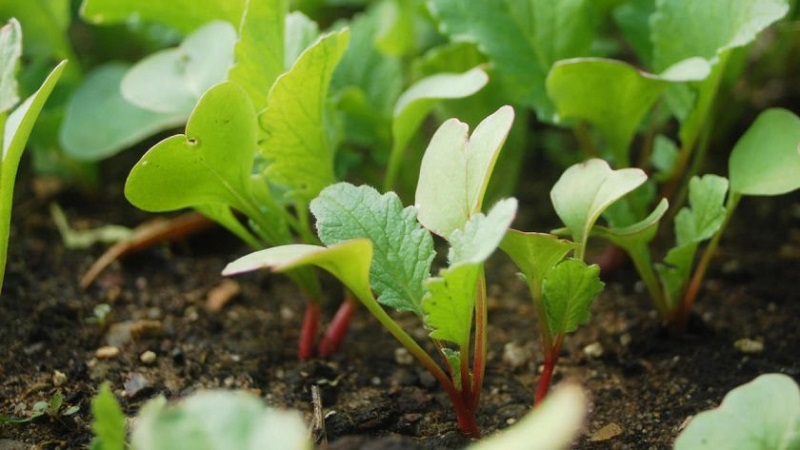
There are ground and underground pests that can spoil root crops. If you see the first signs of damage, act immediately.:
- A common pest is cruciferous fleas (black). They jump over the surface of the leaves and gnaw the tops, leaving holes in it. In the fight against them, ash and tobacco dust are used. If the population is small, lightly dusting the plants with ash is sufficient. For further protection, the radish tops are sprinkled with a mixture of ash and lime (in a ratio of 1: 1) once every 7 days. This is done in dry weather, and after rains, repeat the procedure.In case of mass infestation by fleas, the preparations "Kaiser", "Alfatsin", "Zolon", "Arrivo" are used.
- If caterpillars eat the tops, they are sprayed with a solution of mustard (100 g of dry mustard is mixed with 10 liters of hot water, insisted for two days). Or collect the caterpillars by hand.
- The prevention against wireworms is the addition of onion husks to each hole at the time of planting the radish. If the pest is nevertheless found, use the drug "Bazudin".
- The most dangerous pests of a juicy vegetable are stem nematodes. They feed on the sap of the plant. Chemicals "Vidat", "Dimetoat", "Rogor" will help to destroy parasites.
- Treatment with soapy water (300 g per bucket of water) will help from aphids.
Radish can get sick with keelif it is watered too abundantly. The fungus gets on vegetables from the ground or from humus. In this case, the bed is treated with milk of lime.
If vegetables are infected with mosaics, the fruits slow down in growth, and the tops are covered with a mosaic pattern. The disease is transmitted by insects, or the infection is transmitted through weeds. Sick plants are destroyed.
Vascular bacteriosis affects ripening radishes: the veins of the leaves turn black, and the leaves themselves turn yellow and fall off. A disease occurs due to too abundant watering (or a period of prolonged rains), as well as an invasion of pests. The plantings are sprayed with a 0.1% Planriz solution.
Attention! Most diseases appear as a result of violation of the rules of crop rotation. It is safe to plant radishes in the same place only after 3 years.
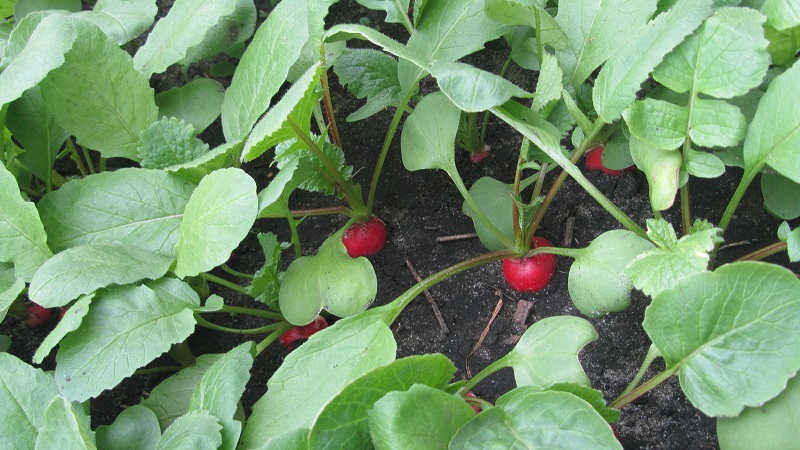
Harvesting
Early varieties ripen 25-30 days after planting, and if they are overexposed in the soil for just a few days, they will lose their taste. Late varieties take longer to fill, but store much better.
Radishes are harvested by pulling the tops... Before pulling the vegetable out of the ground, determine its size - remove a little soil from the top of the fruit. The diameter of a mature root crop exceeds 2.5 cm. Instances that have not grown to this size are given the opportunity to ripen.
Immediately after harvesting, the tops are cut from each radish. Store root vegetables in the refrigerator.
Other varieties and hybrids of radish:
Problems to face
For all the seeming simplicity of growing this juicy vegetable, the harvest does not always turn out the way that summer residents expected. AND it is even more difficult to get high-quality roots in July than in May... It happens that the radish grows crooked and small - this indicates a problem with the soil.

Experienced agronomist tips
Heavy, clayey soils prevent large and even root crops from developing... Therefore, the land in such beds is necessarily lightened. To do this, sand is scattered over the surface of the bed in a layer of 2-3 cm and dug up with the top layer of soil.
When the radish is "wooden" and goes to the arrow, this could be a sign of poor soil. To prevent this from happening, the beds are fertilized with humus or compost before sowing in July.
If the rules of crop rotation and agricultural technology are followed, and instead of harvest growing arrows and flowers, the problem is too long daylight.
Important! When sowing radishes in July, do not leave the beds in the sun all day. Plantings are closed with agrofibre 10 hours after sunrise.
Conclusion
A radish planted in July will yield an excellent harvest if you follow the rules of care and crop rotation. It is especially important to provide shade and abundant watering on hot days.
Timely fight against diseases and pests will not allow them to ruin the juicy and crunchy crop of root crops.